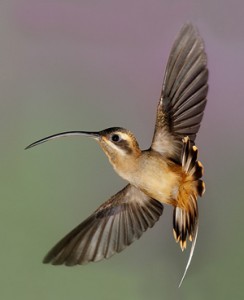Latest update February 23rd, 2025 1:40 PM
Latest News
- Miner dies after tree stump falls on head
- Drunken businessman shoots wife dead during argument
- Taxes collected by Bahamas on Guyana’s oil will soon outweigh our total earnings – Chris Ram
- Gov’t ignores concerns, reappoints Director, members of Environmental Assessment Board for 3rd consecutive year
- Pope Francis in critical condition after health deteriorates, Vatican says
The Long-tailed Hermit (Phaethornis superciliosus)
May 11, 2014 Features / Columnists, Interesting Creatures in Guyana
The Long-tailed Hermit (Phaethornis superciliosus) is a large humming bird that is a resident breeder in Venezuela, the Guianas, and north-eastern Brazil. This species is commonly referred to as the Eastern Long-tailed Hermit, but it is likely, following recommendations from Gary Stiles in February 2006, that the new name will be adopted by most authorities.
The taxonomic history of this group is complicated, with similar hermit populations from both sides of the Andes being originally classed as a single Long-tailed Hermit species. The western population was then split as the Western Long-tailed Hermit, P. longirostris, leading to the renaming of P. superciliosus as Eastern Long-tailed Hermit. The further renaming of P. longirostris as Long-billed Hermit means that P. superciliosus no longer needs “eastern” in its English name.
A further problem relates to the taxonomy of the Long-tailed Hermit versus the Great-billed Hermit (P. malaris). Most taxa previously consider subspecies of the former (insolitus, moorei, ochraceiventris, bolivianus and margarettae) are now considered subspecies of the latter. A satisfactory taxonomic treatment of the entire P. longirostris/P. superciliosus/P. malaris group is still lacking according to some Neotropical ornithologists.
The Long-tailed Hermit inhabits forest undergrowth, usually near water and its preferred food is nectar, taken from large flowers, such as Heliconias, gingers and passion flowers, and small insects and spiders taken as an essential source of protein. Hatchlings are fed by the female with regurgitated invertebrates.
Long-tailed Hermits are trap-line feeders; they do not defend territory, but visit seasonal flowers on routes through the forest up to one km long.
It is 13.5 cm long and weighs 4-6 g. The bill is very long and de-curved (3.6-4.3 cm), with a red tipped black lower mandible, and the central feathers of the tapered tail are long (6.3-6.8 cm) and white-tipped.
The adult Long-tailed Hermit is mainly dull brownish green above with a buff-tinged rump. It has a dark mask through the eye, bordered above and below with whitish-buff stripes. The under parts are pale greyish-buff in colour. The sexes are similar, although the female is slightly smaller.
During the breeding season, male Long-tailed Hermits sing in communal leks of up to several dozen birds, and also wiggle their long tails in display. Competitive lek singing can occupy half of the daylight hours, the purpose of course being to attract females. The female selects the best lek singer to mate with. The song consists of sharp tsuk sounds.
The female Long-tailed Hermit is solely responsible for nest construction, incubation and feeding the young. She lays two white eggs in a conical nest of fibres and cobwebs suspended under a large Heliconia or banana leaf.
(Source: Wikipedia, the free encyclopedia)
Share this:
- Click to print (Opens in new window)
- Click to email a link to a friend (Opens in new window)
- Click to share on Facebook (Opens in new window)
- Click to share on WhatsApp (Opens in new window)
- Click to share on Twitter (Opens in new window)
- Click to share on Pinterest (Opens in new window)
- Click to share on Pocket (Opens in new window)
- Click to share on Tumblr (Opens in new window)
- Click to share on Reddit (Opens in new window)
- Click to share on LinkedIn (Opens in new window)
Related
Similar Articles

The Glenn Lall Show|| February, 14th, 2025
Follow on Tik Tok @Glennlall
THE BLUNT OF THE DAY

Sports
Feb 23, 2025
Kaieteur Sports- The battle lines are drawn. One Guyana Racing Stable is here to make history. With the post positions set for the 2025 Sandy Lane Barbados Gold Cup, all eyes are on Guyana’s rising...Features/Columnists
Crowds, chaos and complaints
Peeping Tom… Kaieteur News- The folly of the cash grant distribution is a textbook case of what happens when a government,... more
Why the U.S. Should Strengthen Trade Ties with the Caribbean
By Sir Ronald Sanders Kaieteur News- A rules-based international trading system has long been a foundation of global commerce,... more
Publisher’s Note
Freedom of speech is our core value at Kaieteur News. If the letter/e-mail you sent was not published, and you believe that its contents were not libellous, let us know, please contact us by phone or email.
Feel free to send us your comments and/or criticisms.
Contact: 624-6456; 225-8452; 225-8458; 225-8463; 225-8465; 225-8473 or 225-8491.
Or by Email: [email protected] / [email protected]
Weekend Cartoon















